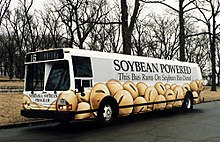Biodiesel
| Subclass of | diesel, biofuel |
|---|---|
| Fabrication method | transesterification |
| Get characteristic | hygroscopy |




Biodiesel be form of diesel fuel dem get from plants anaa animals wey dey consist of long-chain fatty acid esters. Wey typically dem make by chemically reacting lipids lyk animal fat (tallow), soybean oil, anaa sam oda vegetable oil plus alcohol, wey dey produce methyl, ethyl anaa propyl ester by de process of transesterification.[1][2]
Unlike de vegetable den waste oils dem take use to fuel diesel engines dem convert, biodiesel e be drop-in biofuel, wey eget dey mean as ebe compatible plus existing diesel engines den distribution infrastructure. Howeva, dem take mix plus petrodiesel (typically to less dan 10%) since chaw engines no fi run for pure biodiesel top widout modification.[3][4] Biodiesel dey blend wey dem sanso fi use am as heating oil.
De US National Biodiesel Board dey define "biodiesel" as mono-alkyl ester.[5]
Blends
[edit | edit source]Blends of biodiesel den conventional hydrocarbon-based diesel dem komot do chaw commonly distributed for use for de retail diesel fuel marketplace insyd. Much of de world dey use system dem know as de "B" factor make dem state de amount of biodiesel for any fuel mix insyd:[6]
- 100% biodiesel wey dem refer to as B100
- 20% biodiesel, 80% petrodiesel wey dem label B20[3]
- 10% biodiesel, 90% petrodiesel wey dem label B10
- 7% biodiesel, 93% petrodiesel wey dem label B7
- 5% biodiesel, 95% petrodiesel wey dem label B5
- 2% biodiesel, 98% petrodiesel wey dem label B2
Yield
[edit | edit source]Feedstock yield efficiency per unit area dey affect de feasibility of ramping up production to de huge industrial levels dem require make dem power significant percentage of vehicles.
| Crop | Yield | |
|---|---|---|
| L/ha | US gal/acre | |
| Palm oil | 4752 | 508 |
| Coconut | 2151 | 230 |
| Cyperus esculentus | 1628 | 174 |
| Rapeseed | 954 | 102 |
| Soy (Indiana)[7] | 554-922 | 59.2–98.6 |
| Chinese tallow | 907 | 97 |
| Peanut | 842 | 90 |
| Sunflower | 767 | 82 |
| Hemp | 242 | 26 |
References
[edit | edit source]- ↑ Murzin, Dmitry Yu.; Mäki-Arvela, Päivi; Simakova, Irina L. (2012). "Triglycerides and Oils for Biofuels". Kirk-Othmer Encyclopedia of Chemical Technology. pp. 1–14. doi:10.1002/0471238961.trigmurz.a01. ISBN 978-0-471-48494-3.
- ↑ Paisley, Mark A. (2003). "Biomass Energy". Kirk-Othmer Encyclopedia of Chemical Technology. doi:10.1002/0471238961.0621051211120119.a01.pub2. ISBN 978-0-471-48494-3.
- ↑ 3.0 3.1 Omidvarborna; et al. (December 2014). "Characterization of particulate matter emitted from transit buses fueled with B20 in idle modes". Journal of Environmental Chemical Engineering. 2 (4): 2335–2342. doi:10.1016/j.jece.2014.09.020.
- ↑ "Nylund.N-O & Koponen.K. 2013. Fuel and Technology Alternatives for Buses. Overall Energy Efficiency and Emission Performance. IEA Bioenergy Task 46" (PDF). Archived (PDF) from the original on 2020-02-16. Retrieved 2021-04-18.
- ↑ "Biodiesel Basics" (?). National Biodiesel Board. Archived from the original on 2014-08-04. Retrieved 2013-01-29.
- ↑ "Biodiesel Basics - Biodiesel.org". biodiesel.org. 2012. Archived from the original on August 4, 2014. Retrieved May 5, 2012.
- ↑ "Purdue report ID-337" (PDF). purdue.edu. Archived from the original (PDF) on 1 March 2012. Retrieved 9 July 2017.

